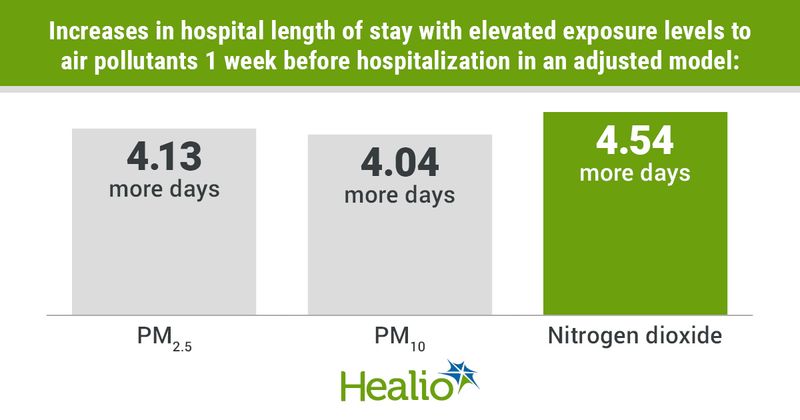Air pollution exposure linked to longer hospital stay in patients with COVID-19
Key takeaways:
- The likelihood for poor outcomes in hospitalization increased with high levels of air pollution prior to illness.
- These findings demonstrate the need to advocate for clean air standards to protect patients.
Exposure to elevated levels of air pollutants before COVID-19 hospitalization increased length of hospital stay and risk for ICU admission, according to study results published in European Respiratory Journal.

“We knew before COVID that the ventilation duration of ICU patients (hospitalized for various reasons) was associated with pre-admission air pollution levels, so in this context, the results are not surprising,” Tim S. Nawrot, PhD, professor of environmental epidemiology at Hasselt University in Belgium, told Healio.

Nawrot, however, said it was "striking" to find that air pollution factors into determining disease severity when it comes to the severe inflammatory response of COVID-19.
Nawrot and colleagues analyzed 328 adults (mean age, 65.7 years; 43.6% women) who were hospitalized with COVID-19 between May 2020 and March 2021 to determine if length of hospital stay and risk for being admitted into the ICU are linked to PM2.5, PM10, nitrogen dioxide and black carbon exposure, as well as the presence of black carbon particles in blood.
Using residential addresses of each patient, researchers collected their exposure levels to each type of pollutant at three different time periods: 2 days prior to hospitalization, 1 week prior to hospitalization and levels averaged from 2016 to 2019. Additionally, a pulsed laser illumination was used to assess blood black carbon particles.
Of the total cohort, 29% were admitted to the ICU, and 16.9 days was the average hospital stay length.
Primary outcomes
When evaluating length of stay, researchers found a relationship between all three evaluated time periods of exposure to PM2.5, PM10 and nitrogen dioxide and more days spent in the hospital.
In an adjusted model for age, sex, BMI, education, neighborhood median income, smoking status, day hospitalized, average temperature on day hospitalized, the Charlson comorbidity index and estimated virus variant, all long-term exposures were linked to longer hospitalization, but significant increases were found with nitrogen dioxide (3.21 more days; 95% CI, 0.83-5.59) and black carbon (2.33 more days; 95% CI, 0.216-4.4).
Exposure to heightened levels of PM2.5 1 week before hospitalization was linked to 4.13 more days (95% CI, 0.74-7.53) in the hospital, which was similar to the rate observed for exposure to PM10 (4.04 more days; 95% CI, 1.24-6.83) and nitrogen dioxide (4.54 more days; 95% CI, 1.53-7.54), according to researchers.
Notably, researchers reported that the observed impact of these pollutants on length of stay was equal to the effect of a 10-year increase in age.
After including gender as an additional variable, researchers found that men exposed to long-term and short-term PM2.5 and PM10 experienced longer hospital stays than women, and this outcome was also observed in men with short-term exposure to nitrogen dioxide.
Switching to evaluating the risk for ICU admission with air pollution exposure, researchers observed that patients had heightened odds for being admitted into the ICU when they had higher long-term exposure to black carbon (OR = 2.26; 95% CI, 1.66-3.21) and nitrogen dioxide (OR = 2.54; 95% CI, 1.81-3.7).
Exposure to elevated levels of nitrogen dioxide 1 week prior to hospitalization was also linked to greater odds for ICU admission (OR = 2.06; 95% CI, 1.38-3.15), according to researchers.
In addition to air pollution exposure, an increase of black carbon particles found in blood signaled a heightened likelihood for progressing to the ICU (OR = 1.36; 95% CI, 1.11-1.7).
Secondary outcomes
Researchers assessed several other outcomes in relation to air pollution exposure, including risk for ventilation, vasopressor usage and arterial partial pressure of oxygen to the fraction of inspired oxygen (PaO2/FiO2).
Patients faced an increased risk for ventilation when they experienced elevated levels of long-term exposure to PM10 (OR = 1.34; 95% CI, 1.02-1.83), black carbon (OR = 1.89; 95% CI, 1.41-2.6) and nitrogen dioxide (OR = 1.93; 95% CI, 1.4-2.72).
The likelihood for using a vasopressor also went up with higher levels of long-term exposure to nitrogen dioxide (OR = 3.16; 95% CI, 2.02-5.15) and black carbon (OR = 2.88; 95% CI, 1.95-4.43), as well as with more black carbon particles in blood (OR = 1.38; 95% CI, 1.05-1.78), according to researchers.
The harmful impact of long-term exposure to high levels of air pollutants was further found when researchers saw decreased PaO2/FiO2 ratios with black carbon (–30.2; 95% CI, –41.8 to –18.6) and nitrogen dioxide (–35.2; 95% CI, –48.6 to –21.8) exposure.
With these findings revealed, Nawrot told Healio there are more areas to explore when considering how air pollution impacts hospitalized patients.
“We might also wonder whether air pollution during hospitalization could be important,” Nawrot told Healio. “Air filtration within ICU and hospital rooms might be relevant. Clinicians further have a key role in advocating clean air as a basic right to enforce regulation.”
Reference:
- Air pollution, even at low levels, made COVID worse for patients and hospitals. https://e3.eurekalert.org/news-releases/992806. Published June 20, 2023. Accessed June 21, 2023.
For more information:
Tim S. Nawrot, PhD, can be reached at tim.nawrot@uhasselt.be.

